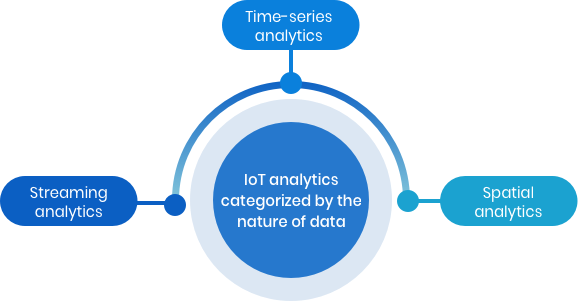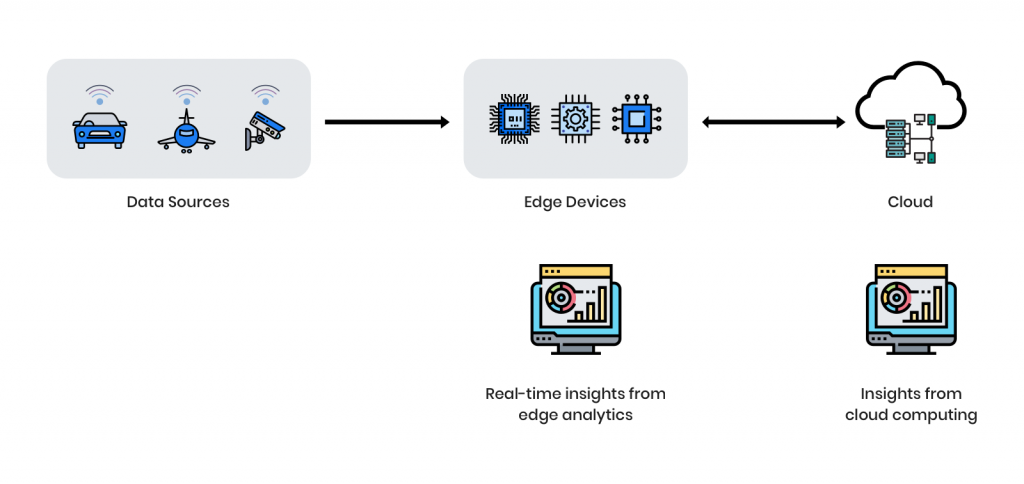The data engineering that precedes analytics was covered in our previous post, Data Engineering: The Heavy Lifting Behind IoT.
Among the many sobriquets that the Internet of Things has acquired, none is more expressive than the term “Internet of Insights.” Incontestably, industrial IoT’s claim to fame is the visibility it brings to previously inaccessible phenomena. The combination of IoT and cutting-edge analytics has pushed the frontiers of business intelligence, emboldening business organizations with better contextual awareness and predictive capabilities.
Applications of IoT Analytics
Indeed, IoT analytics heralds a new era in business intelligence with new pathways for optimization and growth. Application of IoT analytics is not just confined to heavy industries, where it has definitely made a difference, but across other sectors including healthcare, retail, supply chain, logistics, etc.
- Machine condition monitoring
In the past, manufacturers relied on manual inspections to ensure machine reliability. Today, with IoT analytics, they can detect an impending failure by remotely monitoring machine parameters like vibration, temperature, and pressure and intervene proactively, reducing the cost of repair and downtime.
- Automated asset management
When assets go missing or get misplaced, it can cost industries like logistics and healthcare thousands of dollars every year. RTLS- and IoT analytics-backed asset management solutions allow these sectors to track asset movement from anywhere and obtain accurate and up-to-date data on their assets or inventory.
Operations monitoring goes hand in hand with machine monitoring in optimizing factory performance. With IoT analytics, managers can keep tabs on machine performance and productivity and take swift data-driven measures to raise the efficiency of the process, machines, and the workforce.
Predicting time-to-failure offers a bigger opportunity to improve machine uptime and control maintenance costs. Failure patterns gleaned by predictive models from historical data can help forecast the occurrence of similar patterns in the future and help automate the scheduling of maintenance.
Demand forecasting and inventory planning are two challenges that IoT analytics is helping retail industries overcome with more accurate results. From simpler monitoring of products on smart shelves to sophisticated data mining to create predictive models, demand forecasting has come a long way.
Quality is a top priority for original equipment manufacturers (OEM) because their reputation and bottom line are at stake. Now OEMs don’t have to lose sight of their products once they leave the factory floor. They can monitor product performance in real-world conditions, analyze specific categories of failures, and make adjustments to future product designs.
With everything from simple wearables to advanced heart monitors in healthcare, personalization of notifications in proximity marketing, smart metering in the utility industry, telematics-based premiums in auto insurance, product value enhancement through servitization, the customer experience across industries is being reinvented using IoT analytics.
Types of IoT Analytics
The applications mentioned in the previous section represent a mix of analytical methods and approaches. IoT analytics can be seen from two perspectives: the purpose and the nature of data involved in the analytics.

Descriptive Analytics
Of all the analytics types, this is the one that all business organizations are familiar with. It typically involves a simple analysis of data and reporting on Key Performance Indicators (KPIs). The standard questions answered by descriptive analytics are: What happened? When did it happen? How often did it happen? What impact, if any, did it have?
In the context of IoT, descriptive analytics is useful to understand the real-time condition of a connected machine or equipment and check if it is working within safe thresholds. A host of statistical tools are used in descriptive analytics including mean, median, mode, standard deviation, correlation coefficients, frequency tables, and confidence intervals. The results are often represented as a histogram, scatter plot, or correlation map.
Diagnostic Analytics
Diagnostic analytics takes users to the root cause of a problem with the question “why did it happen?”. Sometimes there is no single identifiable cause. Even in that case, diagnostic analysis is useful to uncover causal relationships within data. The tools that assist in diagnostic analytics include drill down and statistical techniques such as correlations, regression analysis, and data mining.
Answers to “what happened”(descriptive analytics) plus “why did it happen” (diagnostic analytics) help weed out actions that lead to adverse outcomes and concentrate resources on those that lead to positive outcomes. For example, a manufacturing plant can leverage diagnostic analytics to understand the energy consumption patterns in a factory and achieve higher energy efficiency by optimizing the number of machines in production.
Predictive Analytics
The advent of cutting-edge statistical analysis, data mining, predictive modeling, and machine learning has taken analytics to a whole new level. These tools enable organizations to analyze the troves of data they accumulate to predict future trends and use that knowledge to preempt adverse events.
In predictive analytics, patterns are abstracted from historical data and used to foretell future outcomes. Data models are trained on past data and are used with algorithms to predict the probability of occurrence of a target variable based on a set of associated variables. These predictive models can be applied to streaming data to make decisions in real time about sales, machine parts failure, and customer behavior.
Prescriptive Analytics
Every decision carries some risk, but what if you could find the optimal decision? That is what prescriptive analytics is about—identifying the best course of action to achieve the desired outcome. Prescriptive analytics draws from various forms of analytics discussed above. A truly sophisticated application of prescriptive analytics is the self-driving car, which applies machine learning on data from GPS, location sensors, and cameras to navigate safely.
To many, the self-driving car may sound too futuristic, but prescriptive analytics has found its way into retail, logistics, supply chain management, and other highly competitive industries. The department store Macy’s, for instance, is held up as an exemplar of how a retail brand can leverage analytics for everything from pricing, tracking shipments, and improving the omnichannel experience.

Streaming Analytics
Analyzing events as they happen marks a major leap in analytics. Data is captured from sensors, devices, databases, and enterprise platforms, and then processed, analyzed, and visualized even as the events unfold in real time. In streaming analytics, millions of events are processed every second to provide real-time visibility and to trigger warnings when deviations are observed. These events are visualized as intuitive graphs and tables, enabling quick detection and action.
Streaming analytics is redefining how companies address security issues, fix pricing, detect machine failure, etc., based on real-time data. It unearths unusual data points or anomalies in data, which could point to faulty behavior of machines, unusual movement of assets or people. Apache Streaming, Flink, and Azure Streaming Analytics are some of the leading frameworks used for streaming analytics.
Time-Series Analytics
IoT-based forecasting solutions harness time-series data, which consists of a series of time-stamped data points. The measurements of the same variable are captured at regular time intervals in time-series data. In time-series analytics, these time-stamped observations are analyzed in the order they occur with the most recent one coming last.
Analytical models built on time-series data are used to predict trends (such as future consumer demand) based on whether the measurements rise or fall and the seasonality based on cyclical changes in data in relation to the calendar. They also help pick up anomalies or unusual patterns in the time-series data, helping users to respond in time to critical events.
Spatial Analytics
Spatial analytics help generate insights regarding the location, distribution, proximity, and spatial relations of observed phenomena. When IoT data is combined with geospatial data, it helps to create more accurate models of the complex world. Thus geo-spatial data contributes toward building rich contextual awareness and making decisions that are appropriate for each geospatial context.
From deciding suitable locations for setting up a business activity to observing changes to a location over time, spatial analytics has several uses. Spatial intelligence is increasingly being used in diverse fields such as crime detection, epidemiological research, traffic management, power, smart parking systems, natural disaster mitigation, fraud detection in insurance, remote asset tracking and logistics.
Edge Analytics
In many IoT applications, the data is pushed to the cloud for processing and analytics. This is fine when the number of devices and the data generated are within manageable limits. But if they are not, as in the case of a Boeing that generates nearly 5 GB data per second, it makes sense to have the computing closer to the sources of data rather than at the far end.
[caption id="attachment_18612" align="aligncenter" width="648"]

Edge computing vs cloud computing[/caption]
Offloading some of the critical computing to the edge and moving data that is not immediately useful to the cloud also helps bring down the cost of cloud storage. This also reduces the time to insights and response, which can be a major competitive differentiator. Low latency is also critical in the case of applications used to monitor public safety as well as in the case of autonomous cars. While the edge computing paradigm is yet to really take off, it can be safely said that we are heading there.
Which IoT analytics can your business benefit from? Or are you struggling to find results from an existing IoT analytics application? Sort it out with a free consultation.


 Edge computing vs cloud computing[/caption]
Offloading some of the critical computing to the edge and moving data that is not immediately useful to the cloud also helps bring down the cost of cloud storage. This also reduces the time to insights and response, which can be a major competitive differentiator. Low latency is also critical in the case of applications used to monitor public safety as well as in the case of autonomous cars. While the edge computing paradigm is yet to really take off, it can be safely said that we are heading there.
Which IoT analytics can your business benefit from? Or are you struggling to find results from an existing IoT analytics application? Sort it out with a free consultation.
Edge computing vs cloud computing[/caption]
Offloading some of the critical computing to the edge and moving data that is not immediately useful to the cloud also helps bring down the cost of cloud storage. This also reduces the time to insights and response, which can be a major competitive differentiator. Low latency is also critical in the case of applications used to monitor public safety as well as in the case of autonomous cars. While the edge computing paradigm is yet to really take off, it can be safely said that we are heading there.
Which IoT analytics can your business benefit from? Or are you struggling to find results from an existing IoT analytics application? Sort it out with a free consultation.


